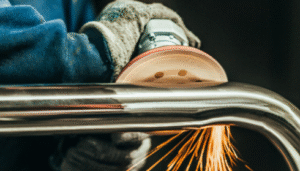
Metal polishing is an essential process in industries and households where metal surfaces play a functional or decorative role. Whether it’s restoring an antique brass lamp, shining up stainless steel kitchen equipment, or preparing components for industrial use, metal polishing is the go-to technique for enhancing appearance, improving durability, and increasing value.
What Is Metal Polishing?
Metal polishing is the process of smoothing and shining metal surfaces by removing oxidation, scratches, and other surface imperfections. It can be achieved through mechanical, chemical, or electrochemical methods. The goal is to achieve a reflective and smooth surface finish that not only looks aesthetically pleasing but also helps extend the life of the object.
This technique is widely used on metals such as stainless steel, aluminum, brass, copper, chrome, and even precious metals like silver and gold. Depending on the material and the level of finish required, different tools, abrasives, and compounds are used.
Benefits of Metal Polishing
There are multiple benefits to polishing metal surfaces:
-
Improved Appearance: Polishing gives metal a clean, bright, and attractive look, making it ideal for decorative items and visible components in architecture or vehicles.
-
Increased Durability: By removing rust and minor corrosion, polishing extends the lifespan of metal objects.
-
Enhanced Cleanliness: A smooth metal surface is easier to clean and maintain, making it suitable for sanitary environments like hospitals and kitchens.
-
Corrosion Resistance: Polishing can help prevent the buildup of corrosive substances by reducing surface porosity.
-
Added Value: Polished metal tends to be more valuable, whether in terms of resale, aesthetics, or functionality.
Metal Polishing Methods
There are several methods used in metal polishing, each with unique applications:
1. Manual Polishing
Manual polishing uses hand tools, polishing cloths, and abrasive compounds. This method is suitable for delicate or small-scale projects, such as jewelry or home fixtures. It gives the polisher full control and is less likely to damage the material.
2. Mechanical Polishing
This method uses machines like rotary buffers, bench grinders, or polishing wheels. It’s faster and more efficient than manual polishing and ideal for large surfaces or industrial-scale work. Various grades of abrasive compounds are used to achieve different levels of shine.
3. Chemical Polishing
Chemical solutions are applied to metal surfaces to dissolve impurities and produce a smooth finish. This method is commonly used in industries dealing with intricate or hard-to-reach components.
4. Electro-Polishing
An advanced process that uses electrical currents and chemical baths to remove a microscopic layer from the surface. It results in a highly reflective and ultra-clean finish, often used in pharmaceutical, aerospace, and food-processing equipment.
Common Tools and Materials
To achieve a successful polish, professionals use a combination of:
-
Buffing wheels and pads
-
Abrasive compounds (e.g., rouge, tripoli)
-
Polishing creams and sprays
-
Microfiber cloths
-
Sandpaper or steel wool
-
Rotary polishers or handheld tools
Safety Tips for Metal Polishing
Polishing metal can generate heat, dust, and chemical fumes. Always wear protective gear like gloves, goggles, and masks. Work in a well-ventilated area and follow all manufacturer instructions on tools and compounds.
Applications of Metal Polishing
Polished metals are used in countless applications including:
-
Automotive parts and accessories
-
Cookware and kitchen appliances
-
Furniture and decorative items
-
Construction materials and architectural details
-
Industrial machinery components
-
Jewelry and watchmaking
Whether you’re a DIY enthusiast or a professional technician, metal finishing plays a crucial role in presenting a final product that is both beautiful and functional.
Final Thoughts
Metal polishing is more than just making things shiny. It’s a critical process that enhances the performance, hygiene, and value of metal products. Whether it’s for aesthetic charm or practical function, learning how to properly polish metal can greatly improve the results of your work.



